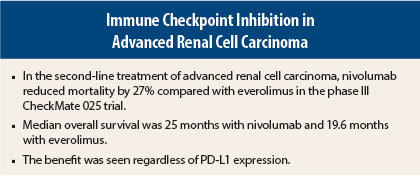Patients with advanced renal cell carcinoma treated with nivolumab (Opdivo) were 27% less likely to die than those receiving everolimus (Afinitor), in a planned interim analysis of the open-label phase III CheckMate 025 trial.1 These positive results prompted an early termination of the study by the data safety monitoring committee.
These study findings were presented at the 2015 European Cancer Congress in Vienna, Austria, by
Padmanee Sharma, MD, PhD, Scientific Director of the Immunotherapy Platform and Professor of Genitourinary Medical Oncology and Immunology at MD Anderson Cancer Center, Houston. The study results were reported by first author Robert J. Motzer, MD, of Memorial Sloan Kettering Cancer Center, and colleagues, and published simultaneously in The New England Journal of Medicine.2 See "Nivolumab and Cabozantinib Improve Outcomes vs Everolimus in Previously Treated Advanced Renal Cell Carcinoma" for more details on CheckMate 025 from the published paper.
“CheckMate 025 met its primary endpoint, demonstrating superior overall survival with nivolumab vs everolimus,” Dr. Sharma announced.
“CheckMate 025 is the first and only study in which immunotherapy with an immune checkpoint inhibitor, used after prior treatment has failed, has shown a benefit in overall survival among patients with advanced kidney cancer. The findings are likely to change the treatment of patients whose disease has progressed on prior treatment,” she predicted.
Patients taking nivolumab, an inhibitor of the programmed cell death protein 1 (PD-1), had a median overall survival of 25 months, compared with 19.6 months for those taking the mTOR inhibitor everolimus.
The international trial recruited 821 patients with advanced renal cell carcinoma of clear cell histology who had received previous antiangiogenic drugs (72% had one prior treatment). Patients were randomized to receive nivolumab at 3 mg/kg intravenously every 2 weeks or everolimus at 10 mg orally once a day.
Patients were followed for at least 14 months. At the July 2015 data cutoff, 17% of the nivolumab arm and 7% of the everolimus arm remained on treatment, whereas 45% and 54%, respectively, had died.
Overall Survival Benefit
The hazard ratio (HR) for death (from any cause) with nivolumab vs everolimus was 0.73 (P = .002), which met the prespecified criterion for superiority “with a highly significant P value,” Dr. Sharma reported. “The overall survival curves separated early and remained separated for the duration of the study.” Numerous subgroups benefitted, including patients deemed to be at poor risk,
she added.
Other Key Outcomes
Objective response rates were almost fivefold higher with nivolumab as well, 25% vs 5% (P < .0001). In each arm, complete responses were observed in 1%, and the median duration of response was 12 months.
“Among responders, there were patients with a long duration of response, including some who went off treatment but still continued to have a response,” Dr. Sharma indicated.
Median progression-free survival was 4.6 months with nivolumab and 4.4 months with everolimus (HR = 0.88; P = .11). The observation that the curves diverged after the median was reached suggests a potential delayed treatment effect with immunotherapy, she added.
The investigators further explored this finding with an ad hoc sensitivity analysis among patients who did not experience disease progression or death by 6 months (35% with nivolumab and 31% with everolimus). In this analysis, median progression-free survival was 15.6 months with nivolumab, vs 11.7 months with everolimus (HR = 0.64).
Nivolumab was effective irrespective of the expression of the PD-1 ligand, PD-L1, suggesting that PD-L1 expression should not be used to select patients for this treatment, Dr. Sharma said. Hazard ratios were 0.79 for patients with PD-L1 expression ≥ 1% and 0.77 for those with PD-L1 expression < 1%.
No New Safety Signals
Treatment-related adverse events of any grade were observed in 79% of those who received nivolumab and 88% of those who received everolimus; grade 3-4 events occurred in 19% and 37%, respectively. The most common grade 3-4 events were fatigue with nivolumab (2%) and anemia with everolimus (8%). Toxicities led to treatment discontinuations in 8% and 13%, respectively, and two patients taking everolimus died as a result of toxicity. There were no treatment-related deaths on the nivolumab arm.
The mean change from baseline in quality-of-life scores on the Functional Assessment of Cancer Therapy–Kidney Symptom Index increased over time and differed significantly from the everolimus group at each assessment through week 76 (P < .05). “We saw a consistent improvement in quality of life with nivolumab vs everolimus,” Dr. Sharma reported. ■
Disclosure: Dr. Sharma has been a consultant for Amgen, AstraZeneca/MedImmune, Bristol-Myers Squibb, and GlaxoSmithKline and has been a consultant and founder with stock in Jounce Therapeutics.
References
1. Sharma P, et al: CheckMate 025. 2015 European Cancer Congress. Abstract 3LBA. Presented September 26, 2015.
2. Motzer RJ, et al: Nivolumab vs everolimus in advanced renal-cell carcinoma. N Engl
J Med. Sept 25, 2015 (early release online).




